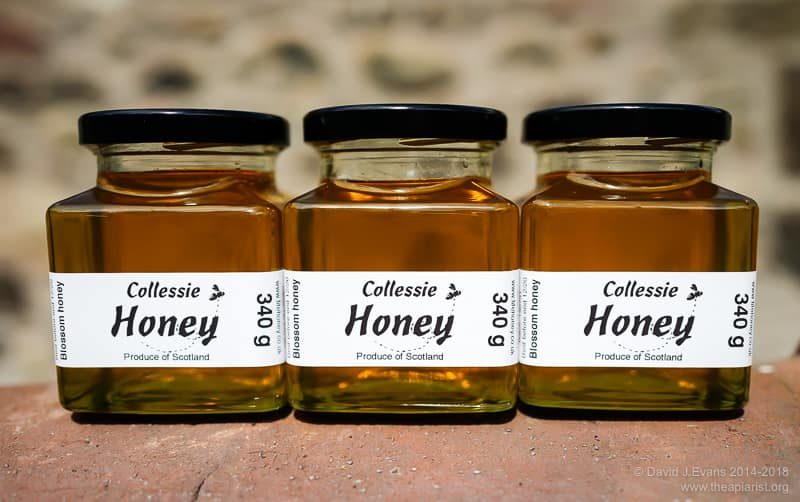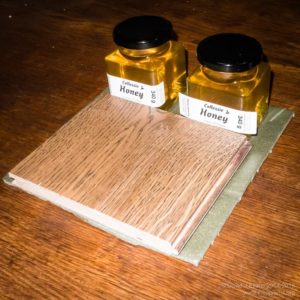Line 'em up
Honey sold via a third party needs to carry a label with all sorts of information on it {{1}}. A well-labelled jar of honey looks good on the shelves and undoubtedly helps sales.
However, an attractive label does not need to be fancy, printed in colour or expensive to produce. I firmly believe that the contrast between a simple black and white label and the rich golden colour of the honey enhances the appearance of the end product. This helps sales.
If you are selling via a shop they are often have more than one type of honey on display. Your honey might well be next to a row of brightly labelled, mass produced (Product of EU and non-EU countries … and we all know what that means), factory packed jars … all looking uniformly – though perhaps blandly – identical.
In contrast you’re selling a top-quality, artisan product that is probably being sold at a premium price.
And if it’s not, it should be.
Artisans and amateurs
Remember that artisan does not mean amateur. It means traditionally produced, high quality and handmade by a skilled tradesman.
Therefore, your honey should not look amateur. If the jar contents look attractive, with no antennae or obvious wax crumbs, and the label is good then the individual jar should be very appealing.
But how do they look half a dozen at a time? All lined up in a row?
If the labels are all higgledy piggledy {{2}}, neither being level on the individual jar or level with its neighbours, then you might not be conveying the impression you want.
Or if you are, you might be able to convey a better impression ?
Line ’em up
With a steady hand, good lighting and a convenient ‘guide’ it is easy to reproducibly label jar after jar after jar after jar after jar {{3}} of honey.
I use offcuts of wood laminate flooring as the guide {{4}}. These are available in a range of thicknesses from about 8 to 15mm. For the sizes of jars I use these represent a suitable distance to place place the label from the bottom of the jar.
I ‘offer up’ the label just touching the wood ‘guide’, check that it’s level and centred on the jar, then press it into place with my thumbs.
Four things that help in getting a reproducible finished effect:
- Easy peel labels that can be removed and reattached if you get it wrong
- Working at a reasonably high table to help with the lateral alignment
- Using square rather than round jars
- Practice
The square jars really help. More specifically it’s the guide butting up against the side of the jar that helps. If I routinely used round jars I’d cut a semi-circular hole in the edge of the guide – in a choice of sizes reflecting the diameter of the jar – to help align the label.
Once the front label is in place it’s a simple (but repetitive) task to turn the jar around and add the anti-tamper label, unless you’re the type who prefers to ‘trap’ it under the front label … in which case it obviously has to go on first.
Alternative approaches
There was a prize awarded recently at one of the large conventions (perhaps the National Honey Show?) for a lovely handcrafted wooden ‘cradle’ that held the jar and aligned the label. The principle was identical to that described above … just implemented much more elegantly. I thought this was made by Thomas Bickerdike who also produces lovely handcrafted wooden spoons. However, my Google-foo has failed to find it, so if you remember seeing it please post a link below.
Or, for a few hundred pounds, you could buy a labelling machine …
Colophon
Line ’em up was a game from US version of the eternally popular game show The Price is Right. Amazingly (have you ever seen it?) this was recently voted the fifth best gameshow of all time.
Extraordinary … but not in a good way.
{{1}}: Batch numbers, a means of identifying the producer, a reserved name, a best before date etc. The honey labelling regulations make a fascinating read … and should be read if you want to avoid the attention of trading standards.
{{2}}: What a great term. It dates back to the 16th Century and means – usually contemptuously – Without any order of position or direction; in huddled or jumbled confusion and disorder; with heads and tails in any or every direction.
{{3}}: It can get a bit repetitive.
{{4}}: Because you can get samples free and we seem to be forever re-flooring rooms.



Join the discussion ...